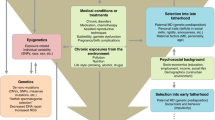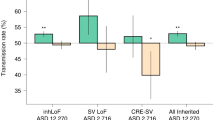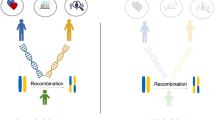Abstract
The offspring of older fathers have higher risk of psychiatric disorders such as schizophrenia and autism. Paternal-age-related de novo mutations are widely assumed to be the underlying causal mechanism, and, although such mutations must logically make some contribution, there are alternative explanations (for example, elevated liability to psychiatric illness may delay fatherhood). We used population genetic models based on empirical observations of key parameters (for example, mutation rate, prevalence, and heritability) to assess the genetic relationship between paternal age and risk of psychiatric illness. These models suggest that age-related mutations are unlikely to explain much of the increased risk of psychiatric disorders in children of older fathers. Conversely, a model incorporating a weak correlation between age at first child and liability to psychiatric illness matched epidemiological observations. Our results suggest that genetic risk factors shared by older fathers and their offspring are a credible alternative explanation to de novo mutations for risk to children of older fathers.
This is a preview of subscription content, access via your institution
Access options
Subscribe to this journal
Receive 12 print issues and online access
$209.00 per year
only $17.42 per issue
Buy this article
- Purchase on Springer Link
- Instant access to full article PDF
Prices may be subject to local taxes which are calculated during checkout





Similar content being viewed by others
References
Frans, E.M. et al. Autism risk across generations: a population-based study of advancing grandpaternal and paternal age. JAMA Psychiatry 70, 516–521 (2013).
Hultman, C.M., Sandin, S., Levine, S.Z., Lichtenstein, P. & Reichenberg, A. Advancing paternal age and risk of autism: new evidence from a population-based study and a meta-analysis of epidemiological studies. Mol. Psychiatry 16, 1203–1212 (2011).
Malaspina, D. et al. Advancing paternal age and the risk of schizophrenia. Arch. Gen. Psychiatry 58, 361–367 (2001).
Pedersen, C.B., McGrath, J., Mortensen, P.B. & Petersen, L. The importance of father's age to schizophrenia risk. Mol. Psychiatry 19, 530–531 (2014).
Petersen, L., Mortensen, P.B. & Pedersen, C.B. Paternal age at birth of first child and risk of schizophrenia. Am. J. Psychiatry 168, 82–88 (2011).
McGrath, J.J. et al. A comprehensive assessment of parental age and psychiatric disorders. JAMA Psychiatry 71, 301–309 (2014).
Kong, A. et al. Rate of de novo mutations and the importance of father's age to disease risk. Nature 488, 471–475 (2012).
Malaspina, D. et al. Schizophrenia risk and paternal age: a potential role for de novo mutations in schizophrenia vulnerability genes. CNS Spectr. 7, 26–29 (2002).
Weinberg, W. Zur Vererbung des Zwergwuchses. Arch. Rass. Gesamte Biol. 9, 710–718 (1912).
Crow, J.F. The high spontaneous mutation rate: is it a health risk? Proc. Natl. Acad. Sci. USA 94, 8380–8386 (1997).
Haldane, J.B.S. The mutation rate of the gene for haemophilia, and its segregation ratios in males and females. Ann. Eugen. 13, 262–271 (1947).
Vogel, F. & Rathenberg, R. Spontaneous mutation in man. Adv. Hum. Genet. 5, 223–318 (1975).
Crow, J.F. The origins, patterns and implications of human spontaneous mutation. Nat. Rev. Genet. 1, 40–47 (2000).
Michaelson, J.J. et al. Whole-genome sequencing in autism identifies hot spots for de novo germline mutation. Cell 151, 1431–1442 (2012).
Iossifov, I. et al. De novo gene disruptions in children on the autistic spectrum. Neuron 74, 285–299 (2012).
Neale, B.M. et al. Patterns and rates of exonic de novo mutations in autism spectrum disorders. Nature 485, 242–245 (2012).
O'Roak, B.J. et al. Sporadic autism exomes reveal a highly interconnected protein network of de novo mutations. Nature 485, 246–250 (2012).
Sanders, S.J. et al. De novo mutations revealed by whole-exome sequencing are strongly associated with autism. Nature 485, 237–241 (2012).
MacArthur, J.A. et al. The rate of nonallelic homologous recombination in males is highly variable, correlated between monozygotic twins and independent of age. PLoS Genet. 10, e1004195 (2014).
Fromer, M. et al. De novo mutations in schizophrenia implicate synaptic networks. Nature 506, 179–184 (2014).
Miller, B. et al. Meta-analysis of paternal age and schizophrenia risk in male versus female offspring. Schizophr. Bull. 37, 1039–1047 (2011).
Mehta, D. et al. Evidence for genetic overlap between schizophrenia and age at first birth in women. JAMA Psychiatry 73, 497–505 (2016).
Day, F.R. et al. Physical and neurobehavioral determinants of reproductive onset and success. Nat. Genet. http://dx.doi.org/10.1038/ng.3551 (2016).
Goriely, A., McGrath, J.J., Hultman, C.M., Wilkie, A.O. & Malaspina, D. “Selfish spermatogonial selection”: a novel mechanism for the association between advanced paternal age and neurodevelopmental disorders. Am. J. Psychiatry 170, 599–608 (2013).
Power, R.A. et al. Fecundity of patients with schizophrenia, autism, bipolar disorder, depression, anorexia nervosa, or substance abuse vs their unaffected siblings. JAMA Psychiatry 70, 22–30 (2013).
Uher, R. The role of genetic variation in the causation of mental illness: an evolution-informed framework. Mol. Psychiatry 14, 1072–1082 (2009).
Sullivan, P.F., Kendler, K.S. & Neale, M.C. Schizophrenia as a complex trait: evidence from a meta-analysis of twin studies. Arch. Gen. Psychiatry 60, 1187–1192 (2003).
Lichtenstein, P., Carlström, E., Råstam, M., Gillberg, C. & Anckarsäter, H. The genetics of autism spectrum disorders and related neuropsychiatric disorders in childhood. Am. J. Psychiatry 167, 1357–1363 (2010).
Ronald, A. & Hoekstra, R.A. Autism spectrum disorders and autistic traits: a decade of new twin studies. Am. J. Med. Genet. B. Neuropsychiatr. Genet. 156B, 255–274 (2011).
Gratten, J., Visscher, P.M., Mowry, B.J. & Wray, N.R. Interpreting the role of de novo protein-coding mutations in neuropsychiatric disease. Nat. Genet. 45, 234–238 (2013).
Gaugler, T. et al. Most genetic risk for autism resides with common variation. Nat. Genet. 46, 881–885 (2014).
Goriely, A. et al. Activating mutations in FGFR3 and HRAS reveal a shared genetic origin for congenital disorders and testicular tumors. Nat. Genet. 41, 1247–1252 (2009).
Moloney, D.M. et al. Exclusive paternal origin of new mutations in Apert syndrome. Nat. Genet. 13, 48–53 (1996).
Rahbari, R. et al. Timing, rates and spectra of human germline mutation. Nat. Genet. 48, 126–133 (2016).
Sanders, S.J. et al. Insights into autism spectrum disorder genomic architecture and biology from 71 risk loci. Neuron 87, 1215–1233 (2015).
Lauritsen, M.B., Pedersen, C.B. & Mortensen, P.B. Effects of familial risk factors and place of birth on the risk of autism: a nationwide register-based study. J. Child Psychol. Psychiatry 46, 963–971 (2005).
Lichtenstein, P. et al. Common genetic determinants of schizophrenia and bipolar disorder in Swedish families: a population-based study. Lancet 373, 234–239 (2009).
Leitsalu, L. et al. Cohort profile: Estonian Biobank of the Estonian Genome Center, University of Tartu. Int. J. Epidemiol. 44, 1137–1147 (2015).
Power, R.A. et al. Polygenic risk scores for schizophrenia and bipolar disorder predict creativity. Nat. Neurosci. 18, 953–955 (2015).
Klei, L. et al. Common genetic variants, acting additively, are a major source of risk for autism. Mol. Autism 3, 9 (2012).
Lee, S.H. et al. Estimating the proportion of variation in susceptibility to schizophrenia captured by common SNPs. Nat. Genet. 44, 247–250 (2012).
Wood, A.R. et al. Defining the role of common variation in the genomic and biological architecture of adult human height. Nat. Genet. 46, 1173–1186 (2014).
Collins, F.S. & Varmus, H. A new initiative on precision medicine. N. Engl. J. Med. 372, 793–795 (2015).
International Schizophrenia Consortium. Common polygenic variation contributes to risk of schizophrenia and bipolar disorder. Nature 460, 748–752 (2009).
Levinson, D.F. et al. Copy number variants in schizophrenia: confirmation of five previous findings and new evidence for 3q29 microdeletions and VIPR2 duplications. Am. J. Psychiatry 168, 302–316 (2011).
Sebat, J. et al. Strong association of de novo copy number mutations with autism. Science 316, 445–449 (2007).
Walsh, T. et al. Rare structural variants disrupt multiple genes in neurodevelopmental pathways in schizophrenia. Science 320, 539–543 (2008).
Sandin, S. et al. The familial risk of autism. J. Am. Med. Assoc. 311, 1770–1777 (2014).
1000 Genomes Project Consortium. A map of human genome variation from population-scale sequencing. Nature 467, 1061–1073 (2010).
Keightley, P.D. Rates and fitness consequences of new mutations in humans. Genetics 190, 295–304 (2012).
Grether, J.K., Anderson, M.C., Croen, L.A., Smith, D. & Windham, G.C. Risk of autism and increasing maternal and paternal age in a large North American population. Am. J. Epidemiol. 170, 1118–1126 (2009).
Falconer, D.S. The inheritance of liability to certain diseases, estimated from the incidence among relatives. Ann. Hum. Genet. 29, 51–71 (1965).
Reich, T., James, J.W. & Morris, C.A. The use of multiple thresholds in determining the mode of transmission of semi-continuous traits. Ann. Hum. Genet. 36, 163–184 (1972).
Acknowledgements
This work was supported by Australian National Health and Medical Research Council (NHMRC) grants to N.R.W. and J.G. (1087889) and to J.G. and P.M.V. (1067795 and 1103418) and by Australian Research Council grant DP130100563 to M.E.G. N.R.W. is supported by an NHMRC Principal Research Fellowship (1078901), P.M.V. is supported by an NHMRC Senior Principal Research Fellowship (1078037), and J.J.M. is supported by grant 1056929 from the John Cade Fellowship from the NHMRC.
Author information
Authors and Affiliations
Contributions
P.M.V., N.R.W., and M.E.G. conceived the idea. J.G., N.R.W., W.J.P., P.M.V., and M.E.G. performed analyses. J.G., P.M.V., and N.R.W. drafted the manuscript, and J.J.M. provided critical feedback. All authors contributed to editing and approval of the final manuscript.
Corresponding author
Ethics declarations
Competing interests
The authors declare no competing financial interests.
Supplementary information
Supplementary Text and Figures
Supplementary Figures 1–6, Supplementary Tables 1–3 and Supplementary Note. (PDF 9538 kb)
Supplementary Code
R scripts for models 1–5. (TXT 47 kb)
Rights and permissions
About this article
Cite this article
Gratten, J., Wray, N., Peyrot, W. et al. Risk of psychiatric illness from advanced paternal age is not predominantly from de novo mutations. Nat Genet 48, 718–724 (2016). https://doi.org/10.1038/ng.3577
Received:
Accepted:
Published:
Issue Date:
DOI: https://doi.org/10.1038/ng.3577
This article is cited by
-
Investigating the impact of paternal aging on murine sperm miRNA profiles and their potential link to autism spectrum disorder
Scientific Reports (2023)
-
A multifactorial model for the etiology of neuropsychiatric disorders: the role of advanced paternal age
Pediatric Research (2022)
-
Expression analysis of selected genes involved in tryptophan metabolic pathways in Egyptian children with Autism Spectrum Disorder and learning disabilities
Scientific Reports (2021)
-
Sperm DNA methylation mediates the association of male age on reproductive outcomes among couples undergoing infertility treatment
Scientific Reports (2021)
-
Associations of parental age with offspring all-cause and cause-specific adult mortality
Scientific Reports (2019)



